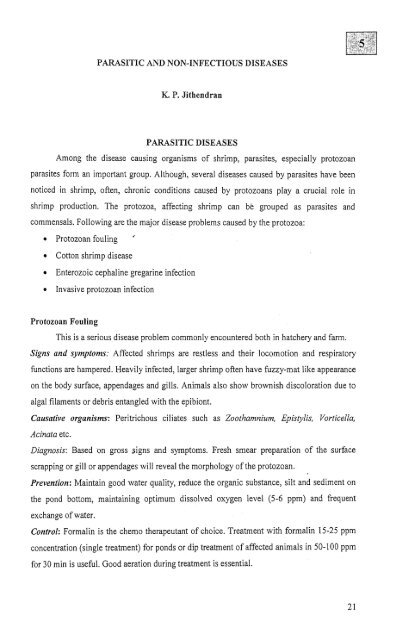, Diagnosis an-&& of Shrimp Diseases - Central Institute of ...
, Diagnosis an-&& of Shrimp Diseases - Central Institute of ...
, Diagnosis an-&& of Shrimp Diseases - Central Institute of ...
- No tags were found...
You also want an ePaper? Increase the reach of your titles
YUMPU automatically turns print PDFs into web optimized ePapers that Google loves.
PARASiTIC AND NON-INFECTIOUS IIISEASESK. P. Jithendr<strong>an</strong>PARASITIC DISEASESAmong the disease causing org<strong>an</strong>isms <strong>of</strong> shrimp, parasites, especially protozo<strong>an</strong>parasites form <strong>an</strong> import<strong>an</strong>t group. Although, several diseases caused by parasites have beennoticed in shrimp, <strong>of</strong>ten, chronic conditions caused by protozo<strong>an</strong>s play a crucial role inshrimp production. The protozoa, affecting shrimp c<strong>an</strong> be grouped as parasites <strong>an</strong>dcommensals. Following are the major disease problems caused by the protozoa:Protozo<strong>an</strong> foulingCotton shrimp diseaseEnterozoic cephaline gregarine infectionInvasive protozo<strong>an</strong> infection"'Protozo<strong>an</strong> FoulingThis is a serious disease problem commonly encountered both in hatchery <strong>an</strong>d farm.Signs <strong>an</strong>d symptoms: Affected shrimps are restless <strong>an</strong>d their locomotion <strong>an</strong>d respiratoryfunctions are hampered. Heavily infected, larger shrimp <strong>of</strong>ten have fuzzy-mat like appear<strong>an</strong>ceon the body surface, appendages <strong>an</strong>d gills. Animals also show brownish discoloration due toalgal filaments or debris ent<strong>an</strong>gled with the epibiont.Causative org<strong>an</strong>ism: Peritrichous ciliates such as Zoothamniwm, Epistylis, Vorticella,Acinata etc.<strong>Diagnosis</strong>: Based on gross signs <strong>an</strong>d symptoms. Fresh smear preparation <strong>of</strong> the surfacescrapping or gill or appendages will reveal the morphology <strong>of</strong> the protozo<strong>an</strong>.Prevention: Maintain good water quality, reduce the org<strong>an</strong>ic subst<strong>an</strong>ce, silt <strong>an</strong>d sediment onthe pond bottom, maintaining optimum dissolved oxygen level (5-6 ppm) <strong>an</strong>d frequentexch<strong>an</strong>ge <strong>of</strong> water.Control: Formalin is the chemo therapeut<strong>an</strong>t <strong>of</strong> choice. Treatment with formalin 15-25 ppmconcentration (single treatment) for ponds or dip treatment <strong>of</strong> affected <strong>an</strong>imals in 50-100 ppmfor 30 min is useful. Good aeration during treatment is essential.
















